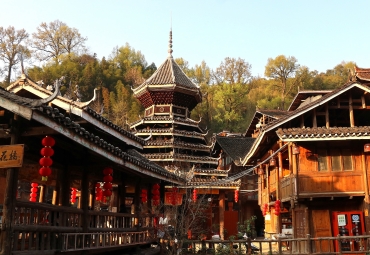Guizhou's ecological remediation projects selected by UN
The United Nations recognizes China's Shan-Shui Initiative as one of the world's 10 ground-breaking projects, honored as World Restoration Flagship.
The Shan-Shui Initiative combines 75 large-scale projects to restore ecosystems, from mountains to coastal estuaries, across the world's most populous nation. Some 3.5 million hectares have been restored. The 2030 target is 10 million hectares.
Launched in 2016, the Initiative results from a systematic approach to restoration. Projects dovetail with national spatial plans, work at the landscape or watershed scale, include agricultural and urban areas as well as natural ecosystems, and seek to boost local industries. All include goals for biodiversity.
The initiative includes the pilot project for ecological protection and restoration in the Wumeng Mountains area, and the integrated protection and restoration of mountains, rivers, forests, farmlands, lakes, grasslands and sand in Wuling Mountains area in Southwest China's Guizhou province.
Both areas are important ecological areas in the upper reaches of the Yangtze River, and the quality of the ecosystems there directly affects the water environment in the Yangtze River basin.
Fanjing Mountain, the tallest peak in the Wuling Mountain Range, contains the most well-preserved primeval forest at its latitude on Earth, and is known as a rich gene pool of animals and plants.
Over the past five years, 653,200 mu (43,546.67 hectares) of the Wumeng Mountains have undergone ecological restoration as part of the pilot project for ecological protection and restoration.
The integrated protection and restoration of mountains, rivers, forests, farmlands, lakes, grasslands and sand in the Wuling Mountains area, which started in 2021, include environmental protection and restoration in 17 counties and districts in the area over the course of three years.
The Oujiang River Headwaters Project in Zhejiang province is one of the Initiative's projects, which integrates scientific knowledge with traditional farming methods, like slope terracing and combining crops with fish- and duck-rearing, to make land use more sustainable.
Countries have already promised to restore 1 billion hectares – an area larger than China – as part of their commitments to the Paris Agreement, the Aichi targets for biodiversity, the Land Degradation Neutrality targets, and the Bonn Challenge. However, little is known about the progress or quality of this restoration. Progress of all 10 World Restoration Flagships will be closely monitored through the Framework for Ecosystem Restoration Monitoring, the UN Decade's platform for keeping track of global restoration efforts.
The winning initiatives, which were unveiled at the UN Biodiversity Conference COP15 in Montreal, were declared World Restoration Flagships and are eligible to receive UN-backed promotion, advice or funding.
They were selected under the banner of the United Nations Decade on Ecosystem Restoration, a global movement coordinated by the United Nations Environment Programme (UNEP) and the United Nations Food and Agriculture Organization (FAO). It is designed to prevent and reverse the degradation of natural spaces across the planet.
Together, the 10 flagships aim to restore more than 68 million hectares − an area bigger than Myanmar, France or Somalia − and create nearly 15 million jobs.
In revealing the World Restoration Flagships, the UN Decade seeks to honor the best examples of large-scale and long-term ecosystem restoration, embodying the 10 Restoration Principles of the UN Decade on Ecosystem Restoration.
"Transforming our relationship with nature is the key to reversing the triple planetary crisis of climate change, nature and biodiversity loss, and pollution and waste," said UNEP Executive Director Inger Andersen. "These 10 inaugural World Restoration Flagships show that with political will, science, and collaboration across borders, we can achieve the goals of the UN Decade of Ecosystem Restoration and forge a more sustainable future not only for the planet but also for those of us who call it home."
"Inspired by these flagships, we can learn to restore our ecosystems for better production, better nutrition, a better environment and a better life for all, leaving no one behind," said Qu Dongyu, director general of the FAO.
The inaugural World Restoration Flagships also include Trinational Atlantic Forest Pact, Abu Dhabi Marine Restoration, Great Green Wall for Restoration and Peace, Ganges River Rejuvenation, Multi-Country Mountain Initiative, Small Island Developing States Restoration Drive, Altyn Dala Conservation Initiative, Central American Dry Corridor, and Building with Nature in Indonesia.
The UN Decade acknowledges the time needed for restoration efforts to deliver results. Regular calls for World Restoration Flagships will be launched until 2030. In expectation of increased funding to the UN Decade's Multi-Partner Trust Fund, additional submissions are being considered, including restoration drives from Pakistan, Peru, and an initiative focusing on Somalia and other drought-affected countries.
All rights Reserved. 京ICP备13028878号-8







 Overview
Overview Guiyang
Guiyang Guian New Area
Guian New Area Liupanshui
Liupanshui Anshun
Anshun Qianxinan
Qianxinan Qiandongnan
Qiandongnan Qiannan
Qiannan Zunyi
Zunyi Tongren
Tongren Bijie
Bijie Guizhou commits to culture preservation and rural vitalization
Guizhou commits to culture preservation and rural vitalization Guizhou voice at 2025 national two sessions
Guizhou voice at 2025 national two sessions Meet the 'genius moms' at Shenzhen cultural fair
Meet the 'genius moms' at Shenzhen cultural fair 

